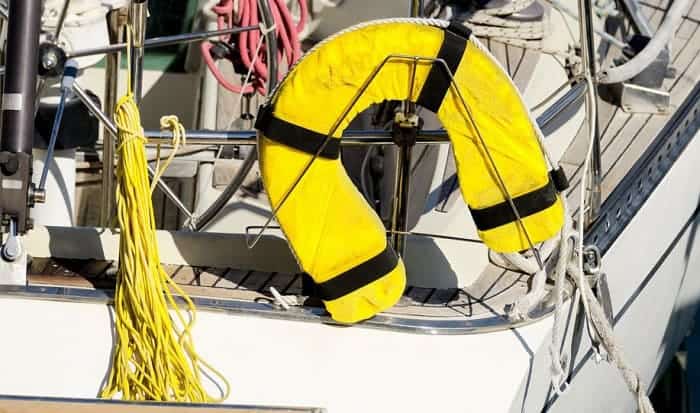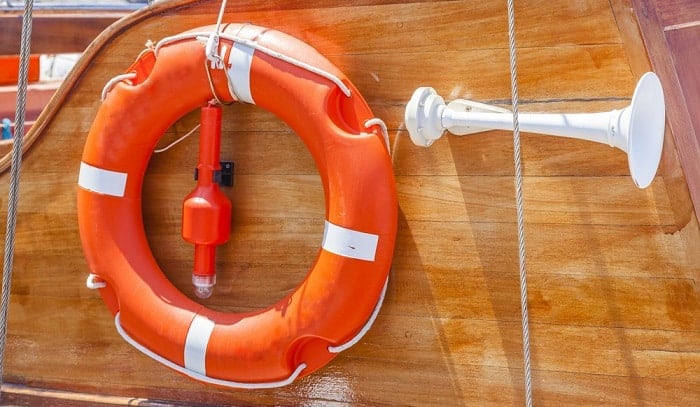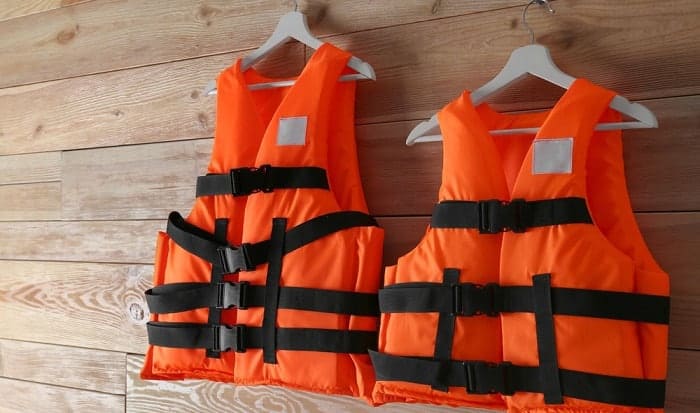Where is the best place to put PFDs while you are out on your boat?’ is one of the most common questions found in nautical or boating education exams. However, it is not only useful for exam takers but also boaters.
PFD or Personal Floatation Device should be on the top deck when you’re out on your boat. It’s best to place them in an accessible area, so you can quickly grab them when an emergency happens.
It’s advisable to wear PFD the entire trip. To gain more knowledge regarding this topic, read on.
Table of Contents
Definition Of PFD (Personal Floatation Device)
Some people call PFD a life jacket. Even though they both keep you floating on the water, there’s a difference between them.
The rear part of the PDF is what offers buoyancy, which, in turn, minimizes awkward movements and makes it easier for you to move around. However, it’s a challenge to float within the dry.
It is a boating safety gear that keeps the head of the wearer out of the water. It prevents the wearer from drowning regardless of whether the person is conscious. PFDs are made in different sizes to accommodate users of various builds and weights.
They also come with multiple features, which allow you to choose based on safety and security needs. You’ll find five types of PDFs, and each has different purposes in protecting you from speed, powerful winds, or cold water.
Recreational boaters and experienced individuals know the significance of this item. Thus, they have it in their vessels. PFDs are also available in various colors. Although they are already in reflective materials, you should select one with bright hues so that you can be easily spotted in the water.
PFDs are always seen during water sports like, such as canoeing, fishing, kayaking, paddle boarding, parasailing, rowing, snorkeling, surfing, water skiing
Where Is The Best Place To Put PFDs While You Are Out On Your Boat
- According to the US Coast Guard, it is highly encouraged to reserve portable PFDs in the correct size for each passenger. For example, you’ll need 4 adult PFDs and two children PFDS if there are four adults and two kids in your boat. Getting the right size of PFD depends on the person’s weight and chest measurement. The exceptions to this rule are people with 140 cm chest and children below 20 pounds. Some PFDs for children that you can consider are STEARNS Child Type II, Stohlquist Waterware, and Lifesaving Pro. The great adult PFDs are from Seachoice, Mustang, Onyx, Astral, and MUSTANG SURVIVAL.
- You’ll need 4 PFDs if your vessel is more than 16 feet long. All of the PFDs should be free from any rips or tears to comply with requirements. Since they are on board, they’re also essential when your boat tows behind a ship.
- Portable PFDs that are inflatable are not recommended for those under 16. It’s not also suitable for sports that have high impact, such as water skiing.
- The best place for PFD
Aside from usage, the best place to put PFD is good to know:
- PFDs should be on clearly visible sections of your boat. The best place is on the top deck because this is where passengers are seated.
- Since the goal is to spot the PDFs easily, it’s reasonable to place them in an open box. Aside from being noticeable, they should be in a safe area. Accessibility is crucial without any covering and obstruction.
- In case of an emergency, you should be able to get your hands on them in the blink of an eye.
PFDs On Children
Based on statistics, 10 US citizens drown each day, and 20% of them are children. Therefore, you can’t just ignore the need for children to wear floatation devices, which should have the right fitness and be well-maintained.
1. What to look for
A label that shows the Coast Guard’s approval
- The grab strap
- Head or collar support
- The right size based on the child’s height
- A zipper that is sturdy and rustproof
- A safety strap and strong buckle
2. Testing PFDs on children
- Take time to teach your children how to wear a PFD or life jacket.
- When determining the percentage of body weight, the child’s head weighs more. Thus, you have to keep in mind that this body part affects the floatation of the PFD.
- Some children may panic when wearing PDF during emergencies. To prevent them from improperly putting on the gear, let them practice from time to time. So, they’ll get used to it.
- Kids who weigh below 9 kg are not required to wear the device. Parental supervision should be supplemented in the place of a PFD.
PFDs On Adults
Be picky when choosing a PFD for yourself. Here are the things that you have to pay attention to:
- There should be a label that indicates the production of the PFD is approved by the US Coast Guard.
- There are various types of PFDs, so make sure you choose the one that suits the sports you’re going to participate in.
- It should suit your weight and size. If it’s too small for you, it won’t be able to support your weight when you’re in the water.
- You should also see to it that it doesn’t restrain your movements.
- It’s clever to get a colorful one, so you can be easily seen, especially if you need assistance when accidents occur.
- When buying one for someone, you should know the person’s size.
- Testing the PFD starts with wearing it then stepping into the water with it. Bend your knees before you make yourself float. Your chin must be peeking out of the PFD, and breathing shouldn’t be a strugg
1. Steps on wearing a PFD
- Step 1. When spreading the device, the inside should be facing the water.
- Step 2. To look at the neck opening, you have to rotate it.
- Step 3. Reach for the arm opening with your arms extended.
- Step 4. Lift your arms above your head.
- Step 5. Position the device on the upper body.
- Step 6. Fasten it well for a snug fit.
2. Taking Care of PFDs
- After contact with saltwater, you have to wash the device with fresh water.
- If it’s necessary, you can use soap, but it should be mild and environmentally friendly.
- Never use gasoline, detergents, and harsh chemicals when cleaning PFDs.
- After washing, you need to drip it dry. Avoid placing it under harsh sunlight and other heat sources.
- When it’s dry, you can store it in a well-ventilated area. It should be separated from moisture and direct sunlight.
- Regular checking of rips, tears, or holes is necessary.
- Also, make sure that zippers, seams, and straps are in good condition.
PFDs VS Life Jackets
Life jackets have more buoyancy than PFDs as they’re designed to prevent unconscious people from not being able to breathe. The goal is the same as using PFDs, but the latter is more for conscious people in calm conditions.
The material that creates buoyancy is in the front of the lifejackets while it’s on the rear side of the PDFs. With the latter, the material is not too bulky and more comfortable to allow free movements.
Lifejackets usually come with a whistle, and the colors are orange, red, and yellow. As mentioned, it’s recommended to choose PFDs in bright colors.
Kids who are not well-versed in swimming should use life jackets. They’ll still be protected even if they get caught in the water by themselves. On the contrary, PDFs are typically used by experienced boaters in recreational activities.
Final Words
Both novice and seasoned boaters should be updated on the essential things and wonder about ‘Where is the best place to put PFDs while you are out on your boat?’. Safety should be everyone’s main concern.
However, emergencies that need PFDs can happen. Placing them in an accessible place is crucial. On top of that, knowing how to wear them is necessary.

“I am James Harvey – founder of Boating Basics Online. It is established with the drive to help out first-time boaters, which are those desiring to explore their way through the water. So if you are new to boating, start from here with me. “



